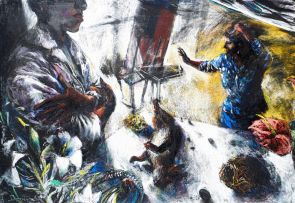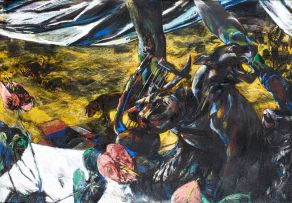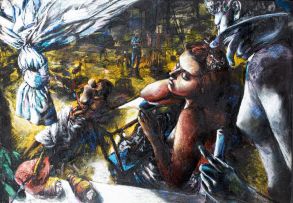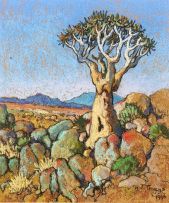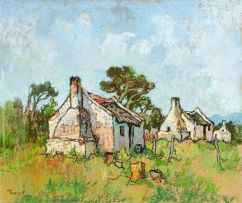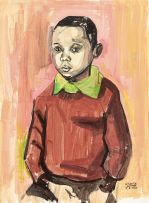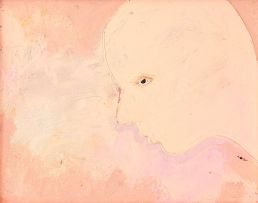Important South African & International Art, Jewellery and Decorative Arts
Live Auction, 12 October 2015
Important South African and International Art, Evening Sale
Incl. Buyer's Premium & VAT
About this Item
signed; each signed, inscribed with the medium, title and the artist's address on the reverse
Notes
Hunting and Nature Scene is one of the finest pastel drawings that Penny Siopis made in the 1980s. The triptych was selected for the prestigious Standard Bank National Drawing Competition in 1987, was exhibited at the National Arts Festival in Grahamstown and toured major museums.
Siopis began working in pastels during her sojourn in Paris in 1986 after being awarded the inaugural Volkskas Atelier Award for her major opus Melancholia1 which allowed her to live and work at the Cité Internationale des Arts. Paris offered Siopis the opportunity to immerse herself in the art of Europe through regular visits to museums and so deepen her longstanding interest in women's subjectivity and the type of art historical representations referenced in Melancholia. But Siopis found it impossible for practical reasons to work in the impasto technique of oil paint in Paris, and so shifted her medium to pastel. She was attracted to the vibrant colours and distinctive materiality of her new medium which she had never used before. As Colin Richards notes, these pastel drawings are 'imbued with the pleasure
of an artist taking liberties with the restricted art materials available in an unfamiliar context'. He observes that they reflect her 'passionate concern with critical forms of femininity, already present in her early cake painting' and how this passion 'has the energy and persistence of both drive and disposition'.
The title Hunting and Nature Scene reflects Siopis' interest in the conventions of representation in art historical paintings where women are unproblematically depicted as nature alongside animals and plants. Siopis challenged these ideas by subtly disrupting the naturalistic form of their depiction through an emphasis on artifice; exaggerated Baroque perspective with strong diagonals, highly charged colour and a theatrical staging of figures and objects. Commenting on her pastels from this period Sue Williamson remarks on their play with high art conventions. 'Many of her pieces are set in an artificial interior world … everything is artfully arranged to create a certain effect, and each object and piece of flesh has its own place and significance. Empty frames, statues, lavishly draped curtains emphasize the artifice of the setting.'
Although Siopis challenges these representations she also recognises her own part in them and reflects this through the inclusion of two self-portraits set in the middle ground of the highly complex composition. In the panel on the left she stands and gestures towards a strong light that is broken by the presence of an easel. In the last panel she reclines holding a baby. It is not uncommon for Siopis to include her own image as one of the 'actors' in her artwork. Her self-portrait in a mirror in Melancholia is a well-known example.
Ideas of fertility and wildness are reflected in the objects, including food and taxidermy that are strewn across the space in the middle ground. Their positioning accentuates the dramatic spatial recession of the scene. The yellow tone becomes darker as it approaches the deeper recesses of the space that are partially obscured by the white curtain above. A studio setting filled with easels and tables is barely visible.
The curtain occupies the upper section of the composition and leads the viewer's eyes along its cascading and dramatic form across the whole drawing. Curtains are a common motif in Siopis' work used to 'set the scene', create drama and to suggest that this is the stage for all the characters in the drawing to act out their role. The bright blues in the crevices and folds of the drapery suggest shadows but also complement the vibrant yellow of the ground beneath it. The curtain or fabric is drawn into a large knot. This knot suggests suppressed emotions, evidence of an undertone of tension and control throughout the drawing.
The foreground comprises a strong white diagonal, a table which extends across all three panels. It displays organic objects and a baroque sculpture that is dramatically centred, its upper part obscured by the curtain. On the table in front of the man is a dead rabbit, a reference Siopis has used in many works, the primary drawing being made in Paris. There is a mention of this rabbit in her interview with William Kentridge in Time and Again in which Kentridge remembers visiting Siopis at the Cité and his daughter being intrigued by the specimen that she kept in the fridge.
On the extreme right hand side a woman holds an animal specimen in a glass box. Behind her is a grayish figure that is actually a sculpture, another reference to art history. It too blurs the lines between the real and the fake, the natural and the man-made.
There is a curious disconnect between the figures represented, as if they are all in their own worlds. On the extreme left is a man of indeterminate race. With arms folded he appears to be witnessing the events. Is he a spectator or an active agent? His eyes are not visible so the exact point of his stare is unclear adding more ambiguity to the whole scene. The creases in his white shirt's sleeve are echoed in the white lilies and the white curtain that cuts across the upper part of the composition.
Linking this drawing to Siopis' painting Melancholia not only serves chronology or context, but also highlights the similarities between the two works even though their medium, scale and format differ. Both are rich in colour and form and seem to be set in an infinite space - a studio with no end in sight. However, in some areas of Melancholia form is created by the physicality of thick paint, whereas in this drawing the colour shapes the form. This is where the artist shows her full set of skills and control over multiple mediums to create dramatic evocative images - a point reiterated time and again across her three decade long career.
1. Melancholia was acquired by the Johannesburg Art Gallery in 1986 and was a key work in the artist's retrospective, Time and Again, which was on view at Iziko South African National Gallery from December 17 2014 to March 23 2015 and Wits Art Museum from 22 April to 20 July 2015.
2. Colin Richards 'Prima Facie' in Kathryn Smith (ed) (2005) Penny Siopis, Johannesburg: Goodman Gallery Editions. Pages 8-9.
3. Sue Williamson (1989) Resistance Art in South Africa. Cape Town: David Phillip. Page 22.
4. Gerrit Olivier (ed) (2014) Time and Again, Johannesburg: Wits University Press. Page 228.
Literature
Julia Meintjes (1987) The Standard Bank National Drawing Competition 1987, Johannesburg: The Standard Press. Illustrated on page 48


